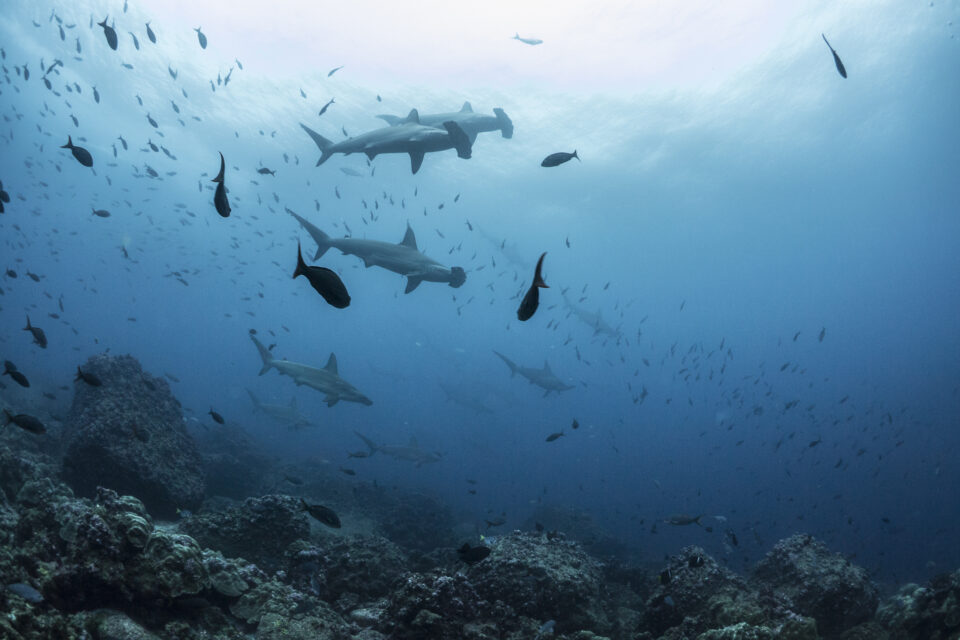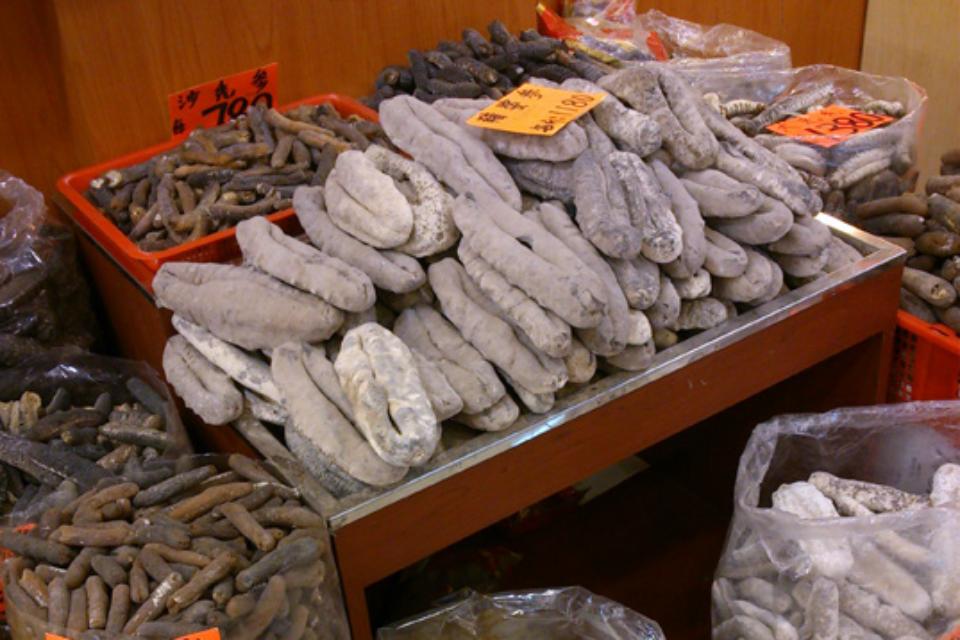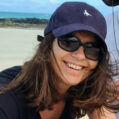

Leadership on the high seas: sink or swim?
At least 250,000 sharks are legally landed as 'by-catch' in Ecuador each year. In July 2020, the news of international fishing vessels anchored along the edge of the Exclusive Economic Zone (EEZ) around the Galapagos Islands hit the headlines.
In July 2020, the news of international fishing vessels anchored along the edge of the Exclusive Economic Zone (EEZ) around the Galapagos Islands hit the headlines.

At least 250,000 sharks are legally landed as ‘by-catch’ in Ecuador each year © Tracey Jennings
These fleets, comprised largely of Chinese fishing vessels, come every year and have been doing so for decades, but the scale of last year’s operation was unprecedented. There were around 300 vessels, some kitted out for fishing, others acting as refrigerated containers and still more serving as refuelling stations. This floating, self-sufficient city-at-sea was just one of many fleets harvesting the marine resources in these rich waters, for much prized squid and tuna but which also end up ensnaring endangered sharks and other threatened species in the process.
Concerned over the loss of biodiversity and food security, in July 2020 Ecuadorian President Lenín Moreno appointed a Commission to design a strategy for the protection of Galapagos and its marine resources. Its remit – to review the marine management of Galapagos – is urgent. But Ecuador’s efforts to protect Galapagos and its marine biodiversity would have a much greater chance of success if there was real and effective support from the international community. It is time to step up our game.
The threat that international fishing poses to both marine biodiversity and international relations is not new. From 1963 to 1975, the United States and Ecuador were embroiled in the so-called ‘tuna war’. The conflict began when Ecuador seized and fined a US fishing vessel that failed to recognize the region up to 200 miles off the coast over which Ecuador felt it had sovereign rights. The tensions abated in 1975, with the creation of a Pacific ‘regional association’ that acknowledged each country’s sovereign right to resource conservation in this offshore zone, an ‘exclusive economic zone’ (EEZ) that most countries around the world eventually signed up to in 1982 as part of the United Nations Convention on the Law of the Sea.

Satellite image of the international fishing fleet in June 2020 © Global Fishing Watch
China has the world’s largest distant-water fishing (DWF) fleet, with a recent report putting the figure at almost 17,000 vessels,some 5-8 times larger than previous estimates. In 2016, China’s DWF fleet captured around two million tonnes of fish, around one-quarter of the global DWF catch. Almost 1000 of these vessels are registered in other countries, ‘flags of convenience’ that can be a way to circumvent regulations. At least 183 vessels in China’s DWF fleet are suspected of involvement in IUU fishing.
Yet this was not enough. In 1998, mounting concerns about decreasing fish populations and the impacts of long-line fishing, Ecuador created the Galapagos Marine Reserve (GMR) to protect an ocean area of 133,000 km2, at the time the second largest marine protected area in the world. The creation of the GMR created a ‘spillover’ effect into the EEZ, which benefit industrial-scale fisheries today.
However, we have yet to factor in another looming threat – climate change. It may be surprising to learn that the greatest impact of climate change is not likely to come from the warming waters around Galapagos impacting marine life directly, but as waters warm faster in other areas, fish populations elsewhere are likely to collapse more rapidly, attracting even more intense fishing activity surrounding the relative sanctuary the GMR.
The Ecuadorian Navy, of course, monitors the annual muster to prevent vessels straying into either Ecuador’s EEZ or the protected waters of the GMR. But is a small Ecuadorian navy a match for a global giant like China? Much was made of the fact that the Chinese government agreed to implement a moratorium on some of its fishing activities in the Pacific for a few months in autumn 2020. However, their fishing activities are limited in those months in any case, so it is increasingly clear that existing protection measures are simply not sufficient to protect this irreplaceable biodiversity, including the catastrophic number of endangered sharks caught as by-catch.
Although catching sharks deliberately is illegal, if caught as by-catch and landed, it is then legal to keep and sell them. One study found that 85% of shark fins for sale in China and Hong Kong originated from the Eastern Pacific – including Ecuador. There has been a dramatic increase in the use of artificial floating objects to attract fish in recent years too. These so-called fish aggregating devices (FADs) released outside the GMR will often drift into it and are notorious for hooking sharks. It is thought that over 250,000 sharks are caught as by-catch in these waters each year, although this figure is likely to be a gross underestimate.

ETP seascape includes international and national waters belonging to Ecuador, Costa Rica, Colombia, Panama. Dashed black lines indicate the EEZ’s for each country © MigraMar
Of course, the impact of industrial-scale fishing is not limited to sharks. The intensity of this extraction threatens many other species. A routine census shows that since the creation of the GMR over 20 years ago, the populations of 13 out of 28 marine species that are surveyed have all declined, with the conservation status of just one species – the olive ridley turtle – showing an improvement. The pressure on the GMR has also had knock-on consequences for the livelihoods of artisanal fisheries in Galapagos, not to mention the alarming mass of plastic from FADs and other waste from these floating cities that washes up on the Islands’ beaches.
Amongst many other measures, Ecuador’s new Commission is considering the creation of a new a marine protected area between Galapagos and Cocos island in Costa Rica. But such proposals are fraught with local and national tensions between conservation groups, government agencies, and fishers. The Galapagos population and the number of registered fishers has continued to increase since 1998, yet there has been no commensurate increase in the access to new fisheries. The COVID-19 crisis has only made matters worse and there is strong opposition to the expansion of Ecuador’s MPAs. Longlining experiments are also taking place in the GMR, and the government is beginning to stall on the implementation of the Commission’s recommendations.
Whilst Ecuador attempts to find solutions that satisfy political, economic and environmental concerns, the international community must work harder and faster to offer its support. In 2017, the UN General Assembly began a process to negotiate a new, international and legally binding treaty for the conservation and sustainable development of marine biodiversity in areas beyond national jurisdiction (BBNJ). The fourth and final negotiating session had been due to take place last year but was postponed by the pandemic. Sticking points remain, yet it is vital that when the participants reconvene, as is expected in August this year, that the draft treaty is not watered down. Ratification of an ambitious and robust High Seas Biodiversity Treaty is long overdue and a vital legislative step if we are really serious about the protection of marine biodiversity in places like Galapagos. This could be a massive help to Ecuador in strengthening its hand. But will this address the threat of illegal, unreported and unregulated (IUU) fishing? Are international tensions likely to increase?
Ecuadorian conservationist Yolanda Kakabadse, and former president of both IUCN and WWF, who was appointed by the President of Ecuador to the Commission, believes international tensions may increase, but above all she feels “China cares about its reputation and there is opportunity for dialogue, particularly on the international stage”.

The impact of industrial fishing could be devastating for the environmental and economic security of Galapagos © Jonathan Green
China is due to host the fifteenth meeting of the Conference of the Parties (COP15) to the Convention on Biological Diversity in October. Delegates will agree on a post-2020 global biodiversity framework, with one of its key targets to ensure that the harvesting, trade and use of wild species will be legal and at sustainable levels by 2030. The COP15 platform presents a big opportunity for China to take the lead on the environment in general and marine protection in particular, to repeat the commitments it made last year regarding its distant-water fishing fleet in the Pacific, act on them and go still further.
Ecuador has often led the way in changing the way the world sees the natural world.
In spite of its small size, Ecuador is a biodiversity hotspot, estimated to be home to an astonishing 10% of all species on Earth. In 1978, Galapagos became the world’s first ever UNESCO World Heritage Site. When Ecuador created the Galapagos Marine Reserve in 1998, it was one of the largest MPAs in the world, second-only to Australia’s Great Barrier Reef. In 2008, Ecuador became the first country to recognise rights for nature in its constitution. It is certainly inEcuador’s interests to avoid a repeat of the 20th-century tuna wars with the US, this time with China. It is in all our interests to help them achieve this: for the protection of Galapagos, for the emergence of truly sustainable fisheries and for treating the natural world with the respect it deserves and so desperately needs.
For several years, GCT has been supporting scientists as they collect evidence to support improvements in marine protection around Galapagos. One of the key proposals is the creation of the Galapagos-Cocos Swimway, a protected area of some 120,000 km2 between Galapagos and Cocos island just off the coast of Costa Rica. It is clear that the ability to migrate between these two World Heritage Sites is important to the biology of at least five endangered species – whale sharks, leatherback turtles, green turtles, silky sharks and scalloped hammerhead sharks.
Without intervention, the impact of industrial fishing is likely to have serious consequences for the environmental and economic security of Galapagos. GCT is working to support:
- Increased dialogue at a provincial and national level between all stakeholders, including all elements of the fishing industry, to find solutions that allow sustainable livelihoods to coexist with, and indeed be enhanced by, conservation action.
- Adoption of more sustainable fishing practices within the GMR as an alternative to the ‘experimental’ longlining
currently taking place. - Support for local and national livelihoods by improving international market access for ‘responsible’ catch.
- Adoption of the new proposal for a strengthened and expanded Galapagos Marine Reserve and for
the designation of the critically important Galapagos-Cocos Swimway. - Increased awareness beyond Ecuador of the impacts of industrial fishing around Galapagos.
- Reduction in the plastic and other pollution generated by national and international fishing fleets.
This article was originally published in the Spring/Summer 2021 edition of Galapagos Matters.
How can you help protect the Cocos-Galapagos Swimway?
Donate to GCT – This is a critical time for sharks globally. They are facing increasing pressures from industrial fishing, habitat loss and plastic pollution. We support research that will ensure protection for sharks.
Adopt a Hammerhead Shark – Learn more about these critically endangered sharks by adopting a scalloped hammerhead shark and supporting the vital conservation work of Galapagos Conservation Trust.
Join Marti – Marti the Hammerhead Shark is our educational children’s book which follows a young shark and her marine friends on an epic migration from Galapagos to Cocos Island.
Related articles


Galapagos marine reserve expansion brings hope - but new management challenges

Global relevance: COVID-19 and sea cucumbers


